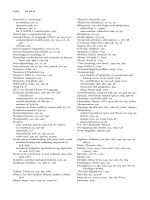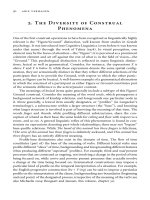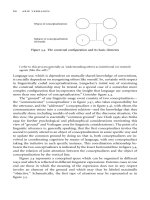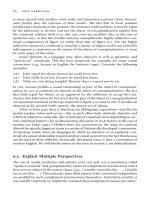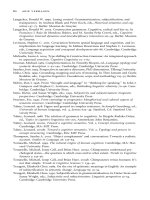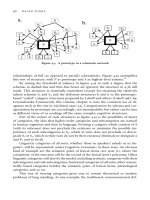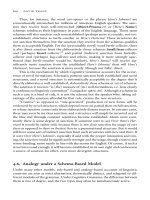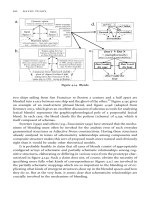The Oxford Handbook of Cognitive Linguistics Part 31 docx
Bạn đang xem bản rút gọn của tài liệu. Xem và tải ngay bản đầy đủ của tài liệu tại đây (161.8 KB, 10 trang )
Consider the English verb pry as in (3a). Analysis shows that certain semantic
components are part of the meaning of pry and must all be matched in the referent
situation for this verb to apply to it. If any component does not fit the situation, a
speaker must switch to some lexical neighbor of pry. A series of alterations to the
situation reveals the essential components. Thus, if there is a one-foot board stuck
vertically to a wall with a handle near the top and I tug on the handle, I cannot say (3a)
but rather something like (3b). Sentence (3a) becomes acceptable here if instead of
using the handle I levered the board away from the wall. Accordingly, one semantic
component essential to the use of pry is that the force for removal of a Figure object
from a Ground object comes from a third object inserted and pivoted between them.
But now say that I do insert and pivot a lever between them so that the board comes
away from the wall, but the board is hinged at the bottom and had been loosely
upright against the wall. I now must say something like (3c). Sentence (3a) again
becomes appropriate only if the Figure is fixed to the Ground and resists removal: the
second essential component. But these two components are still not enough. Let us
now say that the board is fixed to the wall and that I use a lever between them, but the
board comes away from the wall all at once. A more apt sentence is now that in (3d).
Sentence (3a) now becomes apt again only if the Figure moves gradually and pro-
gressively away from the Ground because it has some flexibility: a third essential
component. But now say that instead of a board, a wide foot-long strip of masking
tape is stuck to the wall and that I am progressively removing it with a lever inserted
between the tape and the wall. Now I must say something like (3e). A fourth essential
component is thus that the Figure must be rigid (though with enough give to be
somewhat flexible). What should here be noticed in this whole analysis is that most of
the components just identified do not come readily to mind on hearing the verb pry.
(3) a. I pried the board off the wall.
b. I pulled the board off the wall.
c. I flipped the board off the wall.
d. I popped the board off the wall.
e. I peeled the masking tape off the wall.
The point here is not to work out a specific semantic decomposition but to observe
that, on hearing a morpheme, one may have a vivid sense of its meaning as a whole
but have little conscious access to the particular components essential to that mean-
ing. Such components typically do not spontaneously appear in our consciousness—
so attentionally backgrounded are they—but instead require specialized linguistic
techniques of analysis for us to become aware of them.
Factor Ab3: Weighting among the Components
of a Morpheme’s Meaning
Under factor Ab3, one semantic component within the meaning of a morpheme
can be more salient than another. That is, the semantic components expressed by a
morpheme can have different attentional weightings. This attentional allocation
270 leonard talmy
must be understood as part of the morpheme’s lexicalization pattern. For exam-
ple, while the verb eat includes both the components of ‘chewing’ and of ‘swal-
lowing’, the ‘chewing’ component appears to be more salient in one’s regard of the
eating process than the ‘swallowing’ component, even though the latter can be
shown to be criterial. This observation is perhaps corroborated by the fact that
manner adverbs with eat tend to pick out the ‘chewing’ component rather than
the ‘swallowing’ component as the target of their qualifications. Thus, the sen-
tences You should eat carefully/faster would not generally be taken to mean that
you should swallow carefully or faster, but more likely that you should apply those
manners to your chewing.
A consequence of factor Ab3 is that two different morphemes—or two distinct
senses of a polysemous morpheme—can have roughly the same semantic compo-
nents, but can be weighted differently. Hence, a particular semantic component
can be more salient in one member of such a pair than in the other member. An
example is the semantic component ‘multiple intentional causal agency’ in the two
polysemously related verbs, transitive pass and intransitive pass. The reference of
both these verbs includes the same three semantic components: ‘a Figure object’
(in 4 below, a goblet), ‘multiple intentional causal agency’ (below, diners around a
table), and ‘the motion of the Figure in transit from the grasp of one Agent to that
of another’. But transitive pass is lexicalized to foreground the ‘agency’ component,
in correlation with its representation as subject, as in ( 4a). By contrast, intransitive
pass,asin(4b), is lexicalized to foreground the Figure as subject, while the agency
is now comparatively backgrounded. In fact, this verb has no ready complement
structure in which to represent the agency.
(4) a. They slowly passed the goblet of wine around the banquet table.
b. The goblet of wine slowly passed around the banquet table.
Frame and Prototype Properties of the Morpheme (Ac)
Factor Ac1: A Morpheme’s Direct Reference
versus Associated Concepts
Factor Ac1 involves the distinction between a morpheme’s scope of direct reference
and outside concepts only associated with that reference. Under it, more attention
is on the direct than on the associated concepts. At the same time, the associated
concepts are activated into the ‘‘midground’’ of attention. In one type of frame, the
associated concepts augment the direct reference because, on the one hand, they
add some related conceptual material to it but, on the other hand, they are inci-
dental to it in that they could be dropped or replaced by alternative concepts. To
illustrate, the morphemes north and east in their ‘path’ sense, as in I kept flying north
and I kept flying east, on initial hearing seem semantically identical except for the
compass orientation. But then one may realize that I can fly eastward indefinitely,
circling the globe repeatedly, but that I can fly northward only until reaching the
attention phenomena 271
North Pole, after which I am flying south. With respect to differences in salience, it
seems clear that the concept of compass orientation is foregrounded in attention,
while greatly backgrounded are the concepts of boundedness for north and un-
boundedness for east. Further, in addition to being backgrounded, these latter
concepts seem not to be an intrinsic part of the direct lexicalized references of the
morphemes, but only incidentally associated with them. First, for most local ter-
restrial usage today—and certainly for the usage of past centuries before knowledge
of the global earth—north and east in fact differ only as to compass orientation and
do not depend on any concept of polar terminuses, which could then be dropped
from their associative ambit. Second, such polar terminuses are themselves a con-
vention that could be otherwise. For example, geographers might have instead
agreed to designate travel that starts northward along longitudes in the Western
Hemisphere as remaining continuously northward around those great circles, while
travel in the reverse direction would be southward. Our present understanding
about longitudes and polar terminuses, therefore, appears to be a conception only
incidentally associated with ‘north’, not necessary to it.
A second type of frame involves a set of concepts, ones within a particular
structured interrelation, that co-entail each other. A morpheme can be so lex-
icalized as to refer directly to just one portion of such a set of co-entailed concepts,
while treating the remainder as concepts merely associated with the direct portion.
Two different morphemes can involve the same structured set of co-entailed con-
cepts, while selecting different portions of it for their direct references. The portion
in the morpheme’s direct reference is foregrounded relative to the associated con-
cepts, while the associated concepts come into the midground of attention. Both
Fillmore’s (1976, 1982) term ‘‘frame’’ and Langacker’s (1987) term ‘‘base’’ apply to
such a structured set of co-entailed concepts in the midground of attention. Further,
Fillmore’s term ‘‘highlighting’’ and Langacker’s term ‘‘profiling’’ both refer to the
foregrounding of one portion of the set in a morpheme’s direct reference.
Morphemes of this co-entailment type differ as to whether the associated
concepts must be co-present with the direct reference in both space and time, in
only one of these domains, or in neither. Thus, Langacker’s (1987) example of
hypotenuse does not merely entail the existence of a right triangle in the midground
of attention while referring directly to a particular side of such a triangle in the
foreground of attention, it also requires that the co-entailed triangle be co-present
with the hypotenuse in space and time, with its parts in the proper arrangement.
An isolated length of line is not a hypotenuse but a line segment. Adapting Husserl’s
(1970: 455–57) example, it can next be noted that, in a monogamous context, the
English nouns husband and wife both evoke a married couple in the midground of
attention, while each directly refers in the foreground to one or the other member
of such a pair. Here, the use of, say, wife does not require that the co-entailed
husband be co-present in space, but does require that he be co-present in time, or
else the referent would not be a wife but a widow, divorcee,orfiance
´
e. Finally,
Fillmore’s (1976) ‘commercial scene’ is a structured set of co-entailed concepts,
including a seller, a buyer, goods, money, and their transfers, that any of a number
272 leonard talmy
of verbs—such as sell, buy, spend, pay, charge, cost, and so on—refer to in the
midground of attention, while referring directly in the foreground to a particular
subset of the scene’s components. Here, though, many of these components can be
separated in both space and time, as seen in (5).
(5) I bought her old banjo from her over the phone—she’ll mail it to me next
week, and I’ll send her a check for it after it arrives.
Factor Ac2: Degree of Category Membership
In general, when an addressee hears a morpheme, more of his or her attention is on
the prototype member of that morpheme’s referent, or on an entity with a greater
degree of membership, than on a peripheral or lower-degree member (see, e.g.,
Fillmore 1975, Lakoff 1987 for linguistic prototypes and some of their attentional
correlates). Thus, on hearing the word bird, an American is likelier to have a robin in
consciousness than an ostrich. Comparably, a prototype or higher-degree member
gets more attention than the referential scope of a morpheme as a whole. Thus, if one
hears bird, a robin is likelier to be in consciousness than the whole range of birds.
Polysemy Properties of the Morpheme (Ad)
Factor Ad1: Size of the Polysemous Range of a Morpheme
A concept tends to be more salient when it is expressed by a morpheme that has a
smaller polysemous range and that accordingly can express fewer other concepts,
than when it is expressed by a morpheme with a larger polysemous range covering
more concepts. To illustrate with closed-class forms, the concept ‘higher than and
vertically aligned with’ is expressed by both the prepositions above and over as in
(6a). But above can refer to relatively few other concepts, whereas over can express a
rather larger set of other concepts, including, for example, that of ‘covering a sur-
face’ as in There is a tapestry over the wall (see Brugman and Lakoff 1988). It ac-
cordingly appears that the verticality sense is more prominently, clearly, and un-
ambiguously evoked by above than by over. This difference is especially observable
in a case where the context does not readily eliminate the other senses of the
morpheme with the larger polysemous range, as in (6b).
(6) a. There is a light above/over the chair.
b. There is a poster above/over the hole in the wall.
Factor Ad2: Weighting among the Senses
of a Polysemous Morpheme
The various senses of a polysemous morpheme can be differently weighted with
respect to how readily they are evoked by the morpheme. That is, when a listener
hears the morpheme, some of its senses may come to mind more strongly, while
attention phenomena 273
other senses are more obscure. Accordingly, if the target concept that a speaker
wishes to convey is one of the less salient senses, it might get overwhelmed by more
salient senses unless the context strongly selects for the target concept. Note the
difference between the present factor, Ad2, and factor Ab3. Factor Ad2 pertains to
the salience of a whole concept when it is one sense of a morpheme, relative to the
other senses; factor Ab3 pertains to the salience ofonecomponent of a single concept
relative to the remaining components of that concept.
To illustrate with open-class forms, the concept ‘the particulate material that
plants grow in’ is perhaps the most salient of the senses of the noun soil —certainly
more salient than its sense of ‘land, country’ as in my native soil or of ‘farmland (as
contrasted, e.g., with an urban setting)’, as in I live on the soil. By contrast, the
target concept is less readily evoked by the noun dirt, which on the contrary
allocates greatest salience to another of its senses, that of ‘grime’. Similarly, the
target concept is relatively weak in the polysemous range of the noun earth, which
rather accords greater salience to the sense ‘this planet’ or the sense ‘the surface
land mass’, as in It settled to earth. Where a context clearly selects for the target
concept, as in (7a), a speaker can easily use any of the three nouns. But in an
underdetermined context, as in (7b)—where a morpheme’s most salient sense
tends to be the one that first pops into attention—a speaker might best use the
noun soil to evoke the target concept with minimal confusion.
(7) a. I need to put more soil/dirt/earth in the planter.
b. The soil/?dirt/?earth is slowly changing color.
2.2. Factors Involving Morphology and Syntax (B)
Grammatical and Constructional Properties (Ba)
Factor Ba1: Positioning at Certain Sente nce Locations
versus Other Locations
Each language may have certain locations within a sentence—for example, initial
position or preverbal position—that tend to foreground the referent of a constit-
uent placed there. Such added salience usually accompanies or facilitates a further
cognitive effect, such as making that referent the target of a conceptual contrast.
Many properties of topic and focus, as these have been regarded in the literature,
are often engaged by such special positioning. To illustrate, a sentence like (8a) has
its constituents in their basic locations. But the initial position of the temporal
referent in (8b) foregrounds that referent and suggests a contrast: some other time
would be all right. And the initial position of the Patient referent in (8c) fore-
grounds that referent and suggests a new contrast: another kind of music would be
all right.
274 leonard talmy
(8) a. I can’t stand this kind of music right now.
b. Right now I can’t stand this kind of music.
c. This kind of music I can’t stand right now.
Factor Ba2: Expression in One or Another Grammatical Relation
A cline from greater to lesser prominence tends to be associated with nominals in
accordance with their grammatical relation in a sentence as follows: subject >
direct object > oblique. Consider for example, the two sentences in (9) that
can refer to the same situation involving a landlord and a tenant, but that represent
these two entities oppositely with subject or oblique nominals. In the referent sit-
uation, the landlord and the tenant are equally agentive. The landlord has perhaps
prepared the apartment for new occupancy, advertised it, and interviewed inter-
ested parties. The tenant has perhaps checked newspaper listings, made phone calls,
and visited other vacancies. But greater attention tends to be focused on the entity
mentioned as subject. Associated with this attention is a greater sense that the subject
entity is the main Agent, the one that is the more active and determinative in
the situation, whose volition and intentions initiate and carry forward the reported
action, and whose assumed supplementary activities are taken to be the relevant
ones.
(9) a. The landlord rented the apartment to the tenant.
b. The tenant rented the apartment from the landlord.
Factor Ba2 underlies much of the Figure/Ground phenomena described in
Talmy (2000a: chapter 5). It was noted there—to take just one sector of the
phenomena—that a predicate like be near is not symmetrical, since a sentence like
that in (10a) is semantically distinct from the sentence in (10b). The reason is that,
in such sentences, the subject nominal and the oblique nominal have different
roles, those of Figure and of Ground, respectively. The Figure is a moving or con-
ceptually movable entity whose path, site, or orientation is conceived as a variable
the particular value of which is the relevant issue. And this variable is characterized
with respect to the Ground, a reference entity that has a stationary setting relative
to a reference frame. These are the definitional characteristics. In addition, there
are a number of typically associated characteristics, some of which pertain to at-
tention. Thus, the Ground is more familiar and expected, while the Figure is more
recently in awareness. The Figure is of greater relevance or concern than the
Ground. The Figure is less immediately perceivable than the Ground, but, once
perceived, it is more salient, while the Ground is less salient once the Figure is
perceived. Because of the associated characteristics, a bike is a more natural Figure
than a house, given everyday circumstances, hence the oddity of (10b).
(10) a. The bike is near the house.
b.
?
The house is near the bike.
attention phenomena 275
Compositional Properties (Bb)
Factor Bb1: The Composition versus Its Components
It was proposed under factor Ab2 that the overall meaning of a morpheme is more
in attention than the semantic components analyzable as making it up. In a parallel
way, there seems to be a general tendency for more attention to go to the meaning
of the whole of a composition than to the meanings of the linguistic constituents
that make it up. This tendency manifests itself at two levels of linguistic organi-
zation: the morphemes that make up a word and the words that make up a phrase
or clause. The tendency perhaps applies more strongly to the former of these. Thus,
a speaker or hearer typically might well be more aware of the overall meaning of the
form uneventfulness as a unified word than of the separate meanings of the four
morphemes that make it up, which tend not to stand out individually. This direct
observation may be corroborated by the possibility that there would be only a small
difference in the contents of our consciousness if this complex word were replaced
by a monomorphemic word with roughly the same meaning, like calm (full syn-
onymy of course being virtually impossible), as in a sentence like (11).
(11) The uneventfulness/calm in our household that morning was in stark
contrast with the commotion of the night before.
Although less clearly so than for the word-internal case, more speaker or
hearer attention seems to be on the overall meaning of a portion of discourse than
on the meanings of the words and constructions that make it up. For example, the
overall meaning of the sentence Everyone there gathers in the yard to start the school
day may evoke a Gestalt conception more salient than any of the constituent word
meanings—say, ‘day’, ‘yard’, or ‘school’. And this Gestalt conception may even be
more salient than the sum of all the word meanings and of all the constructions that
the words are in.
Factor Bb2: An Idiomatic versus a Compositional Meaning
An idiom is a linguistic form consisting of two or more morphemes in a construction
whose overall meaning is not derivable by compositional means from the meanings
of the component morphemes in that construction. Factor Bb2 holds that, once such
a form has been selected by a speaker or identified by a hearer as in fact being an idiom,
its overall meaning is stronger in consciousness than any compositional meaning
that might otherwise be attempted for it. For example, once the turn down in (12a) is
determined—in this case by the context provided by its direct object—to be an idiom
basically with the meaning ‘reject’, that meaning is stronger in attention than the
compositional meaning ‘rotate (something) in a downward direction’. For compar-
ison, just such a compositional meaning does emerge in the context of sentence (12b).
(12) a. I turned the offer down.
b. I turned the propeller blade down.
276 leonard talmy
2.3. Factors Involving Forms That Set Attention
Outside Themselves (C)
The attentional factors outside category C generally involve properties of a lin-
guistic unit that set the level of attention for that unit itself. For example, by factor
Aa1, a morpheme’s lexical category affects the attentional strength of its own
referent. By contrast, in the factors of category C, a certain linguistic unit sets
attention for some linguistic unit or nonlinguistic phenomenon fully outside itself.
Specific Linguistic Forms with an Attentional Effect
outside Themselves (Ca)
Factor Ca1: A Form Designating an Outside Referent
as the Object of Attention
A morpheme or construction can set the level of attention on the referent of a
constituent outside itself. Considering here only the case of foregrounding, an
example of a simplex morpheme with this effect is the Tamil particle -ee, which is
cliticized to the constituent whose referent it foregrounds. One of several attention-
directing particles, -ee is mostly associated with the marking of a semantic contrast,
as exemplified by the sentence in (13), taken from Asher (1985).
(13) avan kaaley-iley-ee va-nt-aan
he morning-loc-emph come-pst-m
‘He came in the morning (and not at some other time of day)’
Factor Ca2: A Form Designating a Concomitant
of an Outside Referent as the Object of Attention
Whereas forms under factor Ca1 set attention for the referent of an outside con-
stituent, those of factor Ca2 direct attention to attributes of an outside constituent
apart from its referent. Examples of such attributes are the phonological shape of
the constituent, its vocal delivery, its exact composition, and its shape-referent
linkage. In directing some attention away from the direct referring function of the
constituent—its default function—such forms establish a certain degree and kind
of metalinguistic awareness of the constituent.
For example, the linguistic form be called (compare the monomorphemic
German form heiss[en])asin(14a) directs the hearer to attend not just to the ref-
erent of the following constituent, but especially to the phonological shape of that
constituent and to the linkage of that shape with that referent. By contrast, when
the same constituent appears in a sentence like (14b) without a form like be called,
its presence has the hearer attend simply to its referent.
(14) a. This gadget is called a pie segmenter.
b. Please hand me that pie segmenter.
attention phenomena 277
As a further example, the current youngsters’ expression be like,asin(15),
though often frowned on, is actually unique in English. It presents the expression
that follows as an enactment of an utterance—either an actual utterance or what
likely would be the utterance if the subject’s state of mind were verbalized. The par-
ticular intonation pattern and vocal tones of the expression’s delivery are neces-
sarily divergent from a neutral delivery. The form thus directs a hearer’s attention
not only to the overall referent of the utterance, but also to its style of delivery and,
hence, to the affective state of the subject inferable from that style.
(15) So then I’m like: Wow, I don’t believe this!
Factor Ca3: A Form Designating an Outside Entity
or Phenomenon as the Object of Attention
A form covered by factor Ca1 or Ca2 sets attention only for a linguistic constituent
outside itself, and it indicates which constituent this is to be by its sentential posi-
tioning relative to it. A form covered by factor Ca3 also indicates the setting of
attention for something outside itself. But that something can be any entity or phe-
nomenon within local space or time, not just another linguistic constituent. Further,
the form does not directly indicate which outside entity or phenomenon is to be the
object of attention through its sentential positioning. Rather, it denotes that some
other mechanism is to indicate the object of attention. There is a taxonomy of such
mechanisms. These include temporal proximity (combined with the relative salience
of the intended object of attention), bodily movements by the speaker, and the
speaker’s physical manifestation. All these types are illustrated below. The category of
deictics traditionally termed ‘‘demonstratives’’ is generally the type of forms covered
by factor Ca3. In English the simplex forms of this sort are basically this (these), that
(those), here, there, yonder, now, thus, yea, and stressed he, she,andthey.
For the function of singling out one entity from among others, one mechanism
is the temporal proximity of its occurrence to the moment of speaking, combined
with that object’s own intrinsic salience relative to the remainder of the field. This
mechanism works for virtually any sense modality. For example, one person can
say to another: That’s a cruise ship as they both stand on a pier watching vessels sail
by; That’s a fog horn on hearing such a sound; That’s diesel fuel on catching a whiff
of its smell; or That’s the east wind on feeling the air blowing on his or her skin.
Another mechanism for singling out the speaker’s intended object of attention
is a bodily movement by the speaker. Though the hearer typically views such a
movement, it could be felt (or in some cases even heard). With such a movement,
say, a pointing finger, the object of attention can be a thing or an activity (That’s
my horse/a gallop), a region of space (My horse was over there), or a direction (My
horse went that way).
Third, the speaker’s sheer bodily presence or verbal activity can function to
single out a sufficiently coarse-grained component of the surroundings from al-
ternatives. Thus, where the region of space around the speaker’s body does not
278 leonard talmy
need the finer differentiation that the demonstratives described above can provide,
uttering the word here,asin(16), is enough to identify that region without
additional bodily motion.
(16) a. Pull your wagon over here.
b. There are plenty of restaurants around here.
Comparably, where the temporal interval around the speaker’s current act of
talking needs no finer differentiation than, say, the length of a sentence, uttering
the word now,asin(17), is enough to identify that interval.
(17) a. The telephone is available now.
b. I was sick, but I’m fine now.
On the other hand, if the interval to be singled out is shorter than the length of
a sentence, a speaker can use a finer-grained temporal demonstrative mechanism.
This mechanism is the counterpart of body movements for finer-grained spatial
singling out. Each word in a sentence occupies a specific temporal location in the
stream of time. Designating the word that is coincident with it can single out some
point of that stream. The means for designating the relevant word include stressing
it as well as introducing pauses and stretches in the lead-up to it, as seen in (18).
(18) a. You can save my life if you push the green button riiiiight NOW!
(adapted from Fillmore 1997)
b. The time is exactly 3 o’CLOCK!
Context with an Attentional Effect outside Itself (Cb)
Factor Cb1: Context Designating One Sector of a Morpheme’s
Extended Reference as the Object of Attention
To explain factor Cb1, I begin by observing that there is no known principled way
to distinguish what might be inside a morpheme’s reference ‘‘proper’’ and what
might be outside and only associated with it. I will use the term ‘‘extended ref-
erence’’ to cover this whole range (since Fillmore’s 1976 term ‘‘frame’’ tends to
suggest only external associations). In accordance with one’s conceptualization of
it, a morpheme’s extended reference can have indefinitely many different aspects,
parts, or sectors. By the process at issue here, some one or a few of these can se-
lectively be given more attention than the remainder. The current process is driven
by the morpheme’s context, whether linguistic or nonlinguistic. When a morpheme
occurs as a particular token in an utterance, its context may indicate the current
relevance of only certain elements of the morpheme’s extended reference. Such
context thus largely determines where greater attention is to be located within this
extended reference. This process fits under group Cb factors because the context
directs attention outside itself, namely, with respect to the morpheme for which it
is the context.
attention phenomena 279
